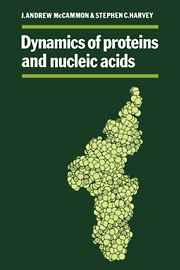Book contents
- Frontmatter
- Contents
- Preface
- 1 Introduction
- 2 Structure of proteins, nucleic acids, and their solvent surroundings
- 3 Dynamics of proteins, nucleic acids, and their solvent surroundings
- 4 Theoretical methods
- 5 Short time dynamics
- 6 Local structural transitions
- 7 Global structural changes
- 8 Dynamics of molecular associations
- 9 Recent developments and future directions
- Appendix 1 Numerical integration of the equations of motion
- Appendix 2 Detailed description of computer programs and procedures for energy minimization and molecular dynamics
- Appendix 3 Molecular dynamics at constant temperature and pressure
- References
- Index
7 - Global structural changes
Published online by Cambridge University Press: 05 June 2012
- Frontmatter
- Contents
- Preface
- 1 Introduction
- 2 Structure of proteins, nucleic acids, and their solvent surroundings
- 3 Dynamics of proteins, nucleic acids, and their solvent surroundings
- 4 Theoretical methods
- 5 Short time dynamics
- 6 Local structural transitions
- 7 Global structural changes
- 8 Dynamics of molecular associations
- 9 Recent developments and future directions
- Appendix 1 Numerical integration of the equations of motion
- Appendix 2 Detailed description of computer programs and procedures for energy minimization and molecular dynamics
- Appendix 3 Molecular dynamics at constant temperature and pressure
- References
- Index
Summary
Introduction
The biological importance of large scale intramolecular motions is obvious. Such motions are an essential part of protein folding, the binding of ligands by proteins, and allosteric effects in enzymes. They are important in a variety of interactions between macromolecules, including the aggregation of antibodies (Yguerabide, Epstein & Stryer, 1970; Hanson, Yguerabide & Schumaker, 1985), the formation of the protein coat of viruses (Harrison, 1978), muscle contraction (Huxley, 1969; Harrington, 1971; Harvey & Cheung, 1982; Eisenberg & Hill, 1985), and the packaging of DNA in the nucleosome (Olins & Olins, 1974; Kornberg, 1974; Levitt, 1978; Sussman & Trifonov, 1978). They may be coupled to local intramolecular motions of the kind described in chapter 6, for example in the repuckering of sugars accompanying the transitions between the A, B and Z conformations in DNA, or in the formation of the environments necessary for some local structural transitions.
Motions that involve most or all of the atoms in a macromolecule occur over a wide range of time scales. The fastest of these motions are small amplitude vibrations whose characteristic times in the absence of solvent (determined from normal mode calculations) may range up to 10 ps. When the effects of solvent are included, the time scale can increase substantially, because the motions are no longer free, undamped oscillations. The time scale will depend on such factors as the masses of the molecular fragments, the elastic force opposing the motion, the friction due to the solvent, and the relative magnitudes of the inertial and viscous forces in the solvent dynamics (the Reynolds number).
- Type
- Chapter
- Information
- Dynamics of Proteins and Nucleic Acids , pp. 137 - 150Publisher: Cambridge University PressPrint publication year: 1987
- 1
- Cited by

